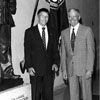
Secret Agent Man
Protecting the nation’s security requires more than security products
- By Ronnie Rittenberry
- Nov 01, 2011
Very late in The Craft We Chose: My Life in
the CIA, author Richard L. Holm writes,
“The United States continues to defend itself
against enemies who are hell-bent on destroying
us. The National Clandestine Service is playing a vital
part in that seemingly unending fight because electronic
intelligence gathering can take us only so far. The
human element is indispensable and must endure.”
Those lines echoed in my head for days after I sat
the book aside, and now I think I know why. For one
thing, I had just read more than 500 pages recounting
circumstances and events that clearly demonstrated
the indispensability of one human—Holm—and
what a difference he made in what we call history, or
even reality.
Clandestine Service
Holm’s memoir—his second, for the record—covers
more than three decades, beginning with his joining
the CIA’s Junior Officer Training program in 1960
and ending with his retirement in 1996, the same year
he received the Distinguished Intelligence Medal,
the agency’s highest award. Those 36 years—more
than a lifetime for too many of his fellow agents—
spanned the Vietnam War, Watergate and its aftermath,
the Iran-Contra affair and the end of the Cold
War, among many other chapters of history. During
those events—indeed, while enswirled in them and
later dealing with their fallout—Holm steadily rose
through agency ranks, working in the Directorate of
Operations—now the National Clandestine Service,
the component directly responsible for collecting human
intelligence—and eventually becoming one of
the agency’s senior operations officers. His career included
deployments to seven countries on three continents
and service under 13 CIA directors.
The book’s chapters, and the years they represent,
fly by, with Holm’s first-person accounts setting the
reader squarely in the midst of them. Throughout,
Holm maintains focus on the art and craft of intelligence
(and counterintelligence) gathering, consistently
referring to it as “tradecraft” as matter-of-factly as others
might discuss shoemaking or metallurgy. He writes:
Most movies and the media in general portray agency
personnel as either cloak-and-dagger types, sometimes
with superhuman abilities, or ruthless bureaucrats who
would rather sacrifice one of their own than give up power.
The fact is we do sometimes train people extensively
before we dispatch them on dangerous missions. It’s also
true that once in a while a rogue wave washes its way into
our sea of personnel.
But the overwhelming truth is that most of what we
do parallels government work in general and much of the
private sector. Some of it is downright ordinary, involving
mountains of paperwork. Someone has to supervise that
ordinary but important work. For a while, and for a part
of it, that someone had to be me.
Before eventually becoming a “headquarters bureaucrat”
(his phrase), Holm served the agency as a
“man on the street” (also his phrase, although given
the crude conditions of some of his missions, it’s using
the phrase loosely). And, as his publisher contends,
Holm’s story does contain “suspense worthy of
a Hollywood blockbuster or a best-selling novel.”
Need-to-Know Basis
One of the most riveting (and, in retrospect, cinematic)
episodes involves Holm’s survival, at age 29,
of a harrowing plane crash in central Africa’s Congo
that burned more than 35 percent of his body and led
to the loss of his left eye. Holm survived the surreal
ordeal on sheer determination (“I simply would not
die in this rotten Congo, I decided”) and with the
angelic assistance of an unnamed Azande witch doctor
and a small band of men who walked and rode
bicycles 100 miles across enemy-held and cannibalinfested
territory to reach help.
Many years later, while serving as a station chief
in Europe and as head of a U.S. counterterrorism
group, Holm participated in the hunt for the international
terrorist and assassin known as Carlos the
Jackal. While caught up in the reading of such experiences,
it is easy to forget that Holm and his fellow
agents were doing such work—and routinely facing
danger as part of it—without the benefit of technologies
that were anywhere on par with the systems
and devices highlighted every month in the pages of
this magazine. At the time, such technologies simply
didn’t exist, but even if they had, Holm’s observation
about the limitations of electronic intelligence gathering
would still ring true.
Holm’s memoir is a testament to that fact, and it’s
a good reminder for those in the security profession
at whatever level—local, national or international. As
good of a read as it is, though, The Craft We Chose is
a book that almost didn’t happen.
In the memoir’s final pages, Holm credits former
CIA Director Richard Helms with convincing him to
overcome reservations he had about chronicling his
mostly secret career. Helms, Holm says, advised keeping
in mind a larger purpose.
“If we don’t write about the Cold War period it
will be written by journalists and academics, and
they will get it wrong,” Helms said, to which Holm
writes, by way of reply, “I couldn’t disagree with
him. . . . Dick Helms knew it is imperative for Americans
to understand and support what the CIA does.
To put it plainly, the agency needs a constituency. He
believed, and I concur wholeheartedly, that the more
the public appreciates what we do, the stronger their
support will be.”
Even if scholars and media types earnestly attempt
the task of reporting the years Holm covers and try
to get things right, they will necessarily lack the insider
vantage of Holm’s lifetime on the streets and
behind closed doors. His work is something worth being
grateful for—both the book itself and the actual
decades of service detailed in its pages.
This article originally appeared in the November 2011 issue of Security Today.